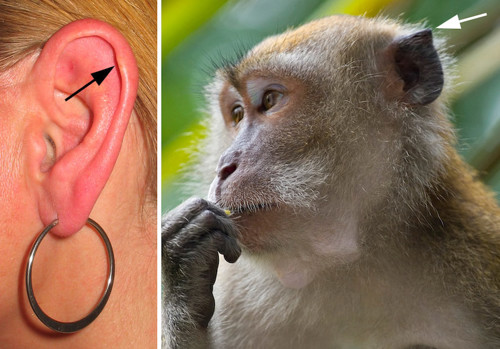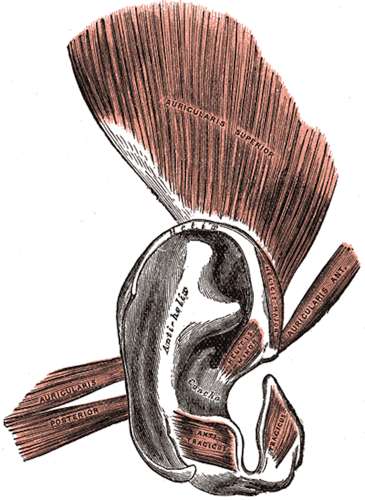
Is the ability to wiggle your ears genetic?
April 16, 2014

- Related Topics:
- Mutation,
- Genetic variation,
- Evolution,
- Editor's choice
A graduate student from Bulgaria asks:
"Is the ability to wiggle your ears genetic? How is it passed on?"
Well, it is certainly genetic in the sense that our genes set up the muscles that let people wiggle their ears. This is the same idea as genes setting up the muscles that let us move our eyes or our tongue or anything else.
What is less clear is how or even whether ear wiggling is passed on. Some people even argue that everyone can learn to wiggle their ears. It just takes practice.
Still, it is obvious that wiggling your ears comes easier for some people. So I suppose another way to ask the question is whether how easy it is to learn to wiggle your ears can be passed on.
After that beautiful set up, the unfortunate answer is we don’t know. We could find only one study that directly addressed your question and it’s from 1949! (Click here and scroll to page 620 if you want to see the original study.)
This study concluded that ear wiggling could only be passed down if one or both parents could wiggle their ears. This is called a dominant trait.
BUT, the researchers in this study also found cases where parents of ear-wigglers couldn’t wiggle! So, it was clear that ear wiggling was not a simple inherited trait.
So, while we have hints, we can’t say for sure whether ear wiggling is passed on. If it is, it isn’t in any simple way.
It could be that having an ear-wiggling gene doesn’t guarantee your ear wiggling ability. Or that multiple genes can affect ear-wiggling ability. Or that having them just makes it easier to learn to wiggle your ears. Or about one hundred other possibilities…
It’s easy to find websites that claim to be able to teach you how to wiggle your ears (click here for example). It’s possible that you can only learn if you have the genetic ability to do so. But as I said, some claim that everyone can learn. Give it a shot and let us know!
What I want to do for the rest of the answer is talk about why we can even wiggle our ears in the first place. It is certainly a fun trait to show off, but not terribly useful.

Ear Wiggling and Evolution
Ear wiggling happens through muscles above and behind your ears called auriculars. In some animals, these muscles are useful because ear movement is helpful. A cat, for example, can move its ears to help it listen for tasty birds.1
But why would humans have these muscles? Way back when, humans and cats had the same ancestors. Ear wiggling was useful to this shared ancestor.
Now, humans and cats have become very different. Ear wiggling is still useful to our feline friends. But for us, it’s just a cool party trick. The name for this is a vestigial trait.
Humans actually have a lot more vestigial traits other than just ear wiggling! For example, wisdom teeth were useful back when our ancestors had bigger jaws and chewed up a lot of tough plants. Now, they mostly just cause us pain and have to be removed.
The tailbone is another great example. It’s left over from ancestors that had tails that they used for balance and movement.2

Gone Forever
If ear wiggling isn’t useful to humans anymore, will it ever disappear? That’s not very likely.
The auriculars came about a very long time ago. For ear wiggling to disappear, these muscles would have to disappear, too. And that wouldn’t be easy. Basically, they would have to mutate away.
A mutation is a small mistake in DNA that happens a lot more than you might think. Our cells are pretty good at repairing mutations, but sometimes one slips through.
If an important part of the DNA gets mutated, the cell or organism with the mutation may not survive. The mutation will die out with it.
But if the mutation happens to something that doesn’t matter, say a gene that leads to a vestigial trait, then the cell or organism will be just fine. If that happens often enough, that trait disappears.

This is what happened to being able to make vitamin C in people and guinea pigs. We each have the necessary gene; it has just become so mutated, it doesn’t work anymore!3
This is also why dogs have a much stronger sense of smell than humans. Dogs have about 220 million odor receptors. Humans have gradually lost the need for all of these and built up mutations, so now we only have 5 million.4
However, for the auriculars, it’s unlikely they will mutate enough to disappear. They may not serve much purpose, but they still form an important base for the ear. Evolution can only build on what came before, so it might not be possible to get rid of them and still have ears!
Read More:
- Gizmodo: Ten vestigial traits you didn’t know you had
- More on the evolution of mutations
- Other human traits that are more complicated genetically than advertised
- Med Hypotheses: Ear wiggling might aid recovery after traumatic brain injury and stroke (Maybe ear wiggling isn't so useless after all!)

Author: Dara Strauss-Albee
When this answer was published in 2014, Dara was a Ph.D. candidate in the Department of Immunology, studying natural killer cells in HIV infection in Catherine Blish's laboratory. She wrote this answer while participating in the Stanford at The Tech program.
 Skip Navigation
Skip Navigation
